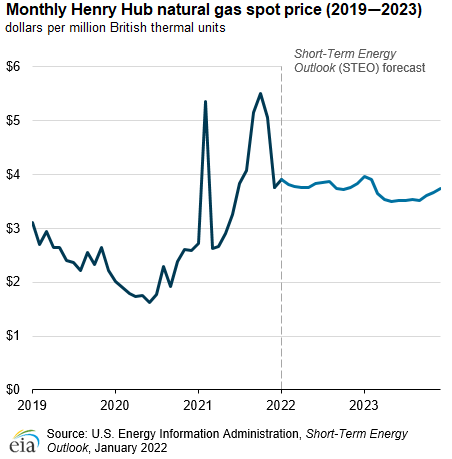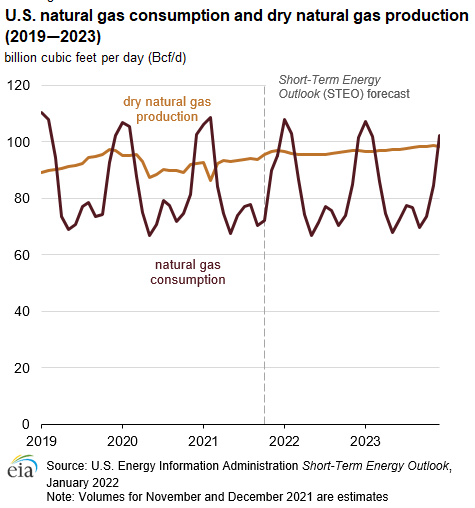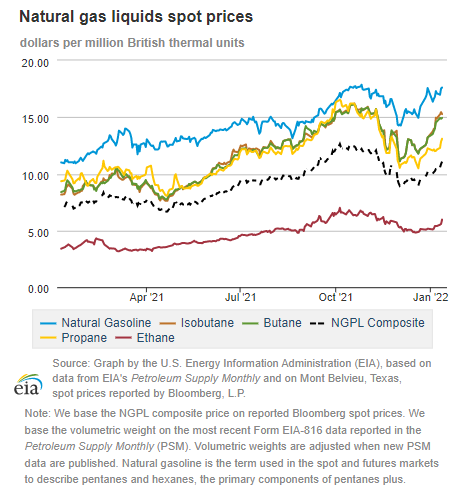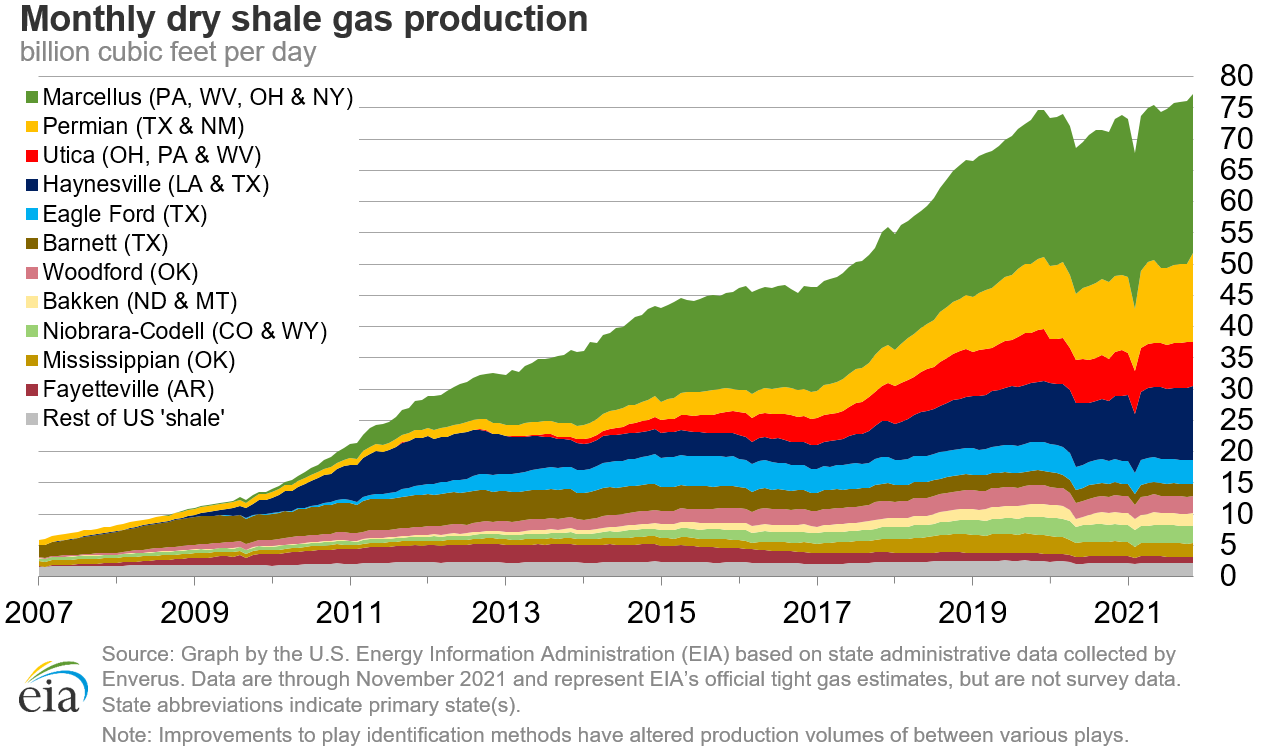In the News:
EIA forecasts natural gas prices to remain near $4/MMBtu in 2022, lower in 2023
In our January Short-Term Energy Outlook (STEO), we forecast that the natural gas spot price at the U.S. benchmark Henry Hub will average $3.79 per million British thermal units (MMBtu) in 2022, 12 cents below its 2021 average of $3.91/MMBtu. Average monthly natural gas prices increased between March and October 2021, but they declined in the last two months of the year. We expect natural gas prices to continue declining, on an annual average basis, through 2023, averaging $3.63/MMBtu, as growth in dry natural gas production outpaces growth in domestic demand and exports.
Recent volatility in the natural gas spot price at the Henry Hub near the end of 2021 contributed to increased uncertainty in our price forecast. Deviations from winter weather expectations, the potential for extreme weather events such as this past year’s February cold snap, and a rise in demand for natural gas imports in Europe and Asia—where spot prices have reached record highs in the past few months—all contributed to last year’s variability in natural gas prices.
We forecast that the Henry Hub spot price will remain relatively flat for most of 2022. We expect growth in natural gas production, growth in U.S. natural gas exports, and relatively unchanged domestic consumption. We expect natural gas prices to decline beginning in 2023, particularly at the close of the 2022–23 winter heating season, as production grows, U.S. liquefied natural gas (LNG) exports and pipeline exports to Mexico increase slightly, and consumption in the industrial and electric power sectors remains similar to 2022 levels.
We expect domestic dry natural gas production to grow 2.7% to a record-high 96.0 billion cubic feet per day (Bcf/d) in 2022, and to 97.6 Bcf/d in 2023. We forecast annual U.S. natural gas consumption will remain relatively unchanged in 2022 and increase slightly in 2023 as a result of increased consumption in the industrial sector, offset by a decline in natural gas consumed in the electric power sector as more renewable electric power plants are installed.
We expect U.S. exports of natural gas—both by pipeline to Mexico and Canada and in the form of LNG to overseas destinations—to continue to grow, especially as new U.S. LNG terminals come online and reach full production.
Overview:
(For the week ending Wednesday, January 12, 2022)
- Natural gas spot price movements were mixed this report week (Wednesday, January 5 to Wednesday, January 12). The Henry Hub spot price rose from $3.79 per million British thermal units (MMBtu) last Wednesday to $4.59/MMBtu yesterday.
- International natural gas prices increased this report week. Bloomberg Finance, L.P. reports that swap prices for liquefied natural gas (LNG) cargos in East Asia for the balance of the month (January) rose $1.08 to a weekly average of $33.87/MMBtu. At the Title Transfer Facility (TTF) in the Netherlands, the most liquid natural gas spot market in Europe, the day-ahead prices rose $1.57 to a weekly average of $28.07/MMBtu. In the same week last year (week ending January 13, 2021), prices in East Asia and at TTF were $16.91/MMBtu and $7.97/MMBtu, respectively.
- The price of the February 2022 NYMEX contract increased 97.5 cents, from $3.882/MMBtu last Wednesday to $4.857/MMBtu yesterday. The price of the March 2022 NYMEX contract also increased sharply this week, by 61.7 cents, from $3.71/MMBtu last Wednesday to $4.327 yesterday. The price of the 12-month strip averaging February 2022 through January 2023 futures contracts climbed 48.7 cents to $4.325/MMBtu.
- The net withdrawals from working gas totaled 179 billion cubic feet (Bcf) for the week ending January 7. Working natural gas stocks totaled 3,016 Bcf, which is 6% lower than the year-ago level and 2% more than the five-year (2017–2021) average for this week.
- The natural gas plant liquids composite price at Mont Belvieu, Texas, rose by 54 cents/MMBtu, averaging $10.68/MMBtu for the week ending January 12. The ethane price rose 7%, following the 8% increase in the natural gas price at the Houston Ship Channel and the 9% increase in the ethylene price. The propane price rose 3%, reflecting higher seasonal consumption of propane as a space heating fuel, along with elevated exports. Normal butane and isobutane prices rose 8% and 9%, respectively, due to higher demand for butane as a motor gasoline blending component. The natural gasoline price followed the Brent crude oil price, increasing 4% for the week ending January 12.
- According to Baker Hughes, for the week ending Tuesday, January 4, the natural gas rig count increased by 1 to 107 rigs. Compared with this time last year, 23 more natural gas-directed rigs were operating this report period. The number of oil-directed rigs rose by 1 to 481. The total rig count increased by two, and it now stands at 588, a 63% increase from a year ago.
Prices/Supply/Demand:
Prices along the Gulf Coast rise in response to increased flows of natural gas to the Midwest and East Coast. This report week (Wednesday, January 5 to Wednesday, January 12), the Henry Hub spot price rose 80 cents from a weekly low of $3.79/MMBtu last Wednesday to a weekly high of $4.59/MMBtu yesterday. The Henry Hub price rose by 53 cents yesterday, the largest daily price increase since October 5, 2021. Flows out of South Louisiana rose 37% this report week in response to rising natural gas consumption throughout the eastern United States as a cold front swept through most of the Lower 48 states that lie east of the Rockies.
Prices in the Midwest rise in advance of colder temperatures. At the Chicago Citygate, the price decreased 2 cents from $4.43/MMBtu last Wednesday to $4.41/MMBtu yesterday. Prices at the Chicago Citygate remained relatively flat throughout the week, at slightly below $4.00/MMBtu, but rose yesterday in advance of a new cold front moving into the region. Temperatures in the Chicago area have remained well below normal for most of the week, averaging slightly above 18°F this report week, which is more than 7°F below normal and resulted in 325 heating degree days (HDDs—a measure of heating demand). Temperatures rose yesterday to an average of 36°F (11°F above normal), but they are expected to fall again and remain low through Monday. Natural gas prices rose yesterday as a result of the anticipated low temperatures and related increase in demand in the Midwest.
Prices in the West fall due to lower consumption and moderate temperatures. The price at PG&E Citygate in Northern California fell 3 cents, from $5.37/MMBtu last Wednesday to $5.34/MMBtu yesterday. The price at SoCal Citygate in Southern California decreased 40 cents from $5.95/MMBtu last Wednesday to $5.55/MMBtu yesterday. Temperatures in Riverside, California, inland from Los Angeles, rose this report week and averaged 59°F, 4°F above normal compared with 52°F (3°F below normal) last week, resulting in lower space heating demand. According to IHS Markit, natural gas consumption in California declined about 760 million cubic feet per day (MMcf/d) on average this week, driven by a 17% (630 MMcf/d) decrease in consumption in the residential and commercial sectors. Total natural gas consumption in the Pacific Northwest also fell this week by about 755 MMcf/d week over week. The price at Sumas on the Canada-Washington border, the main pricing point for the Pacific Northwest, fell 23 cents from $5.20/MMBtu last Wednesday to $4.97/MMBtu yesterday. Supply into Southern California remains impaired by a continuing outage on the El Paso Natural Gas (EPNG) pipeline. Kinder Morgan, operator of the pipeline, reports in its latest Maintenance Update that flows on Line 2000 through the Cimarron compressor station, which has a segment capacity of 600 MMcf/d, will remain at zero through the end of January.
Prices in the Northeast surge due to cold temperatures and increased demand for space heating. At the Algonquin Citygate, which serves Boston-area consumers, the price went up $7.40 from $11.56/MMBtu last Wednesday to $18.96/MMBtu yesterday. The price along the Portland Natural Gas Transmission System (PNGTS), a pipeline that connects New England markets with supply sources in Canada, rose $5.56 week over week to $18.75/MMBtu yesterday. In contrast, after rising to a weekly high of $16.29/MMBtu last Thursday, the price at the Transcontinental Pipeline Zone 6 trading point for New York City decreased $2.32 from $7.66/MMBtu last Wednesday to $5.34/MMBtu yesterday. Natural gas consumption in the Northeast rose 31% (7.4 Bcf/d) to 31.4 Bcf/d and reached a daily high this heating season of close to 36 Bcf/d on January 11, according to IHS Markit. Well-below-normal temperatures were reported across New England this week, particularly on Tuesday, when the daily low in Portland, Maine, fell to 0°F, more than 17°F below normal, and the daily low in the Boston area fell to 8°F, 15°F below normal. As a result, natural gas consumption in New England increased 23% (0.8 Bcf/d) to 4.1 Bcf/d, driven by a 40% increase (0.8 Bcf/d) in residential/commercial sector consumption. In response to high natural gas prices and limited natural gas supplies, coal and petroleum-fired electricity generating capacity was brought online to supplement the electricity supply mix this week.
Prices in the Appalachia production region rise due to increased demand in the Northeast. The Tennessee Zone 4 Marcellus spot price increased 98 cents from $3.32/MMBtu last Wednesday to a weekly high of $4.30/MMBtu yesterday. The price at Eastern Gas South in southwest Pennsylvania rose 92 cents from $3.38/MMBtu last Wednesday to $4.30/MMBtu yesterday, also a weekly high. Average temperatures were below freezing most of this report week. Daily temperatures in the Pittsburgh area averaged less than 24°F this report week, approximately 15°F below last week’s average and more than 5°F below normal. Although temperatures throughout the Appalachia production region fell to well-below-normal levels, no freeze-offs were reported and natural gas production in the Appalachia region was relatively flat at 33.9 Bcf/d this week compared with 34.6 Bcf/d last week, according to IHS Markit data.
The price discount in the Permian Basin production region relative to Henry Hub increases and production holds steady in the region. The price at the Waha Hub in West Texas, which is located near Permian Basin production activities, rose 35 cents this report week, from $3.76/MMBtu last Wednesday to $4.11/MMBtu yesterday. The Waha Hub traded 48 cents below the Henry Hub price yesterday compared with last Wednesday, when it traded 3 cents below the Henry Hub price—the lowest discount relative to the Henry Hub since late June 2021. Natural gas production in Texas was flat from week to week at 23.3 Bcf/d, and production in the Permian Basin held steady at close to 14.0 Bcf/d, according to IHS Markit data.
U.S. total natural gas supply increases week over week as a result of higher net imports from Canada. According to data from IHS Markit, the average total supply of natural gas rose by 0.7% (0.7 Bcf/d) from a week ago. Dry natural gas production decreased by 0.6% (0.5 Bcf/d) from the previous report week, but average net imports from Canada more than offset this decline by increasing 25.1% (1.2 Bcf/d) from last week.
U.S. consumption of natural gas increases substantially for the second report week in a row across all sectors. U.S. residential and commercial sector natural gas consumption increased by 20.0% (8.5 Bcf/d) as a result of below-average temperatures across most of the Lower 48 states. The rise in the residential and commercial sector natural gas consumption accounted for most of the increase in total U.S. consumption, which rose by 10.7% (10.3 Bcf/d) compared with the previous report week, according to data from IHS Markit. Natural gas consumed for power generation climbed by 3.4% (1.0 Bcf/d); industrial sector consumption also increased by 3.4% (0.9 Bcf/d). Natural gas exports to Mexico increased 15.4% (0.7 Bcf/d), and natural gas deliveries to LNG export facilities (LNG pipeline receipts) averaged 12.2 Bcf/d, or 0.3 Bcf/d higher than last week.
U.S. LNG exports increased by one vessel this week from last week. Twenty-five LNG vessels (nine from Sabine Pass, five from Freeport, four each from Cameron and Corpus Christi, two from Cove Point and one from Elba Island) with a combined LNG-carrying capacity of 92 Bcf departed the United States between January 6 and January 12, 2022, according to shipping data provided by Bloomberg Finance, L.P.
Storage:
The net withdrawals from storage totaled 179 Bcf for the week ending January 7, compared with the five-year (2017–2021) average net withdrawals of 155 Bcf and last year's net withdrawals of 134 Bcf during the same week. Working natural gas stocks totaled 3,016 Bcf, which is 72 Bcf more than the five-year average and 199 Bcf lower than last year at this time.
According to The Desk survey of natural gas analysts, estimates of the weekly net change to working natural gas stocks ranged from net withdrawals of 164 Bcf to 209 Bcf, with a median estimate of 178 Bcf.
The average rate of withdrawals from storage is 23% lower than the five-year average so far in the withdrawal season (November through March). If the rate of withdrawals from storage matched the five-year average of 15.4 Bcf/d for the remainder of the withdrawal season, the total inventory would be 1,738 Bcf on March 31, which is 72 Bcf higher than the five-year average of 1,666 Bcf for that time of year.
More storage data and analysis can be found on the Natural Gas Storage Dashboard and the Weekly Natural Gas Storage Report.
See also:
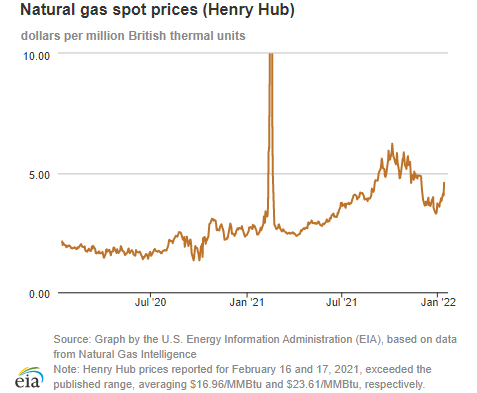
| Spot Prices ($/MMBtu) | Thu, 06-Jan |
Fri, 07-Jan |
Mon, 10-Jan |
Tue, 11-Jan |
Wed, 12-Jan |
|---|---|---|---|---|---|
| Henry Hub |
3.93 |
3.83 |
4.14 |
4.06 |
4.59 |
| New York |
16.29 |
8.80 |
12.41 |
5.40 |
5.34 |
| Chicago |
3.92 |
3.96 |
3.97 |
3.88 |
4.41 |
| Cal. Comp. Avg.* |
5.08 |
4.74 |
4.87 |
4.85 |
5.25 |
| Futures ($/MMBtu) | |||||
| February contract | 3.812 |
3.916 |
4.079 |
4.249 |
4.857 |
| March contract |
3.670 |
3.726 |
3.834 |
3.968 |
4.327 |
| *Avg. of NGI's reported prices for: Malin, PG&E Citygate, and Southern California Border Avg. | |||||
| Source: NGI's Daily Gas Price Index | |||||
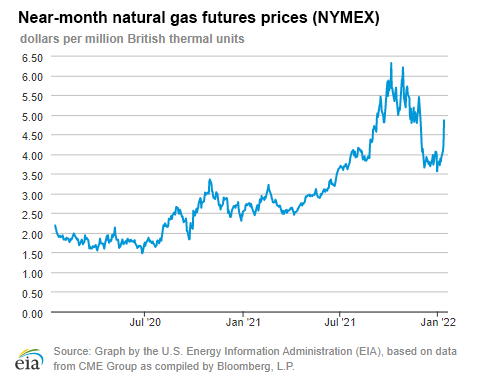
| U.S. natural gas supply - Gas Week: (1/6/22 - 1/12/22) | |||
|---|---|---|---|
Average daily values (billion cubic feet) |
|||
this week |
last week |
last year |
|
| Marketed production | 105.4 |
106.0 |
102.6 |
| Dry production | 93.8 |
94.3 |
91.9 |
| Net Canada imports | 6.0 |
4.8 |
6.2 |
| LNG pipeline deliveries | 0.2 |
0.2 |
0.3 |
| Total supply | 100.0 |
99.3 |
98.4 |
|
Source: Chart by the U.S. Energy Information Administration (EIA), based on data from IHS Markit | |||
| U.S. natural gas consumption - Gas Week: (1/6/22 - 1/12/22) | |||
|---|---|---|---|
Average daily values (billion cubic feet) |
|||
this week |
last week |
last year |
|
| U.S. consumption | 106.6 |
96.3 |
100.0 |
| Power | 30.2 |
29.2 |
29.6 |
| Industrial | 25.7 |
24.8 |
25.4 |
| Residential/commercial | 50.7 |
42.2 |
45.0 |
| Mexico exports | 5.6 |
4.8 |
5.6 |
| Pipeline fuel use/losses | 7.5 |
7.3 |
7.2 |
| LNG pipeline receipts | 12.2 |
11.9 |
11.2 |
| Total demand | 131.9 |
120.3 |
124.1 |
|
Source: Chart by the U.S. Energy Information Administration (EIA), based on data from IHS Markit | |||
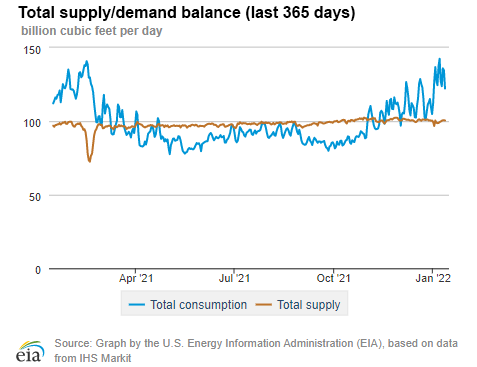
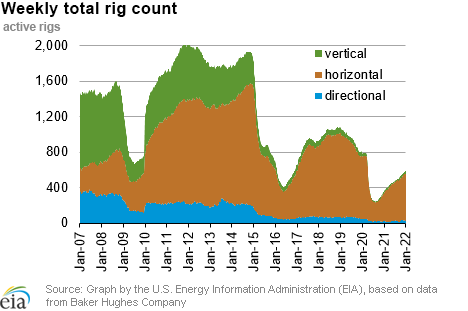
| Rigs | |||
|---|---|---|---|
Tue, January 04, 2022 |
Change from |
||
last week |
last year |
||
| Oil rigs | 481 |
0.2% |
74.9% |
| Natural gas rigs | 107 |
0.9% |
27.4% |
| Note: Excludes any miscellaneous rigs | |||
| Rig numbers by type | |||
|---|---|---|---|
Tue, January 04, 2022 |
Change from |
||
last week |
last year |
||
| Vertical | 23 |
-11.5% |
27.8% |
| Horizontal | 532 |
0.4% |
66.3% |
| Directional | 33 |
10.0% |
50.0% |
| Source: Chart by the U.S. Energy Information Administration (EIA), based on data from Baker Hughes Company | |||
| Working gas in underground storage | ||||
|---|---|---|---|---|
Stocks billion cubic feet (Bcf) |
||||
| Region | 2022-01-07 |
2021-12-31 |
change |
|
| East | 730 |
767 |
-37 |
|
| Midwest | 835 |
893 |
-58 |
|
| Mountain | 159 |
172 |
-13 |
|
| Pacific | 204 |
219 |
-15 |
|
| South Central | 1,088 |
1,143 |
-55 |
|
| Total | 3,016 |
3,195 |
-179 |
|
|
Source: U.S. Energy Information Administration Form EIA-912, Weekly Underground Natural Gas Storage Report | ||||
| Working gas in underground storage | |||||
|---|---|---|---|---|---|
Historical comparisons |
|||||
Year ago (1/7/21) |
5-year average (2017-2021) |
||||
| Region | Stocks (Bcf) |
% change |
Stocks (Bcf) |
% change |
|
| East | 732 |
-0.3 |
688 |
6.1 |
|
| Midwest | 885 |
-5.6 |
823 |
1.5 |
|
| Mountain | 189 |
-15.9 |
168 |
-5.4 |
|
| Pacific | 279 |
-26.9 |
246 |
-17.1 |
|
| South Central | 1,131 |
-3.8 |
1,019 |
6.8 |
|
| Total | 3,215 |
-6.2 |
2,944 |
2.4 |
|
| Source: U.S. Energy Information Administration Form EIA-912, Weekly Underground Natural Gas Storage Report | |||||
| Temperature – heating & cooling degree days (week ending Jan 06) | ||||||||
|---|---|---|---|---|---|---|---|---|
HDDs |
CDDs |
|||||||
| Region | Current total |
Deviation from normal |
Deviation from last year |
Current total |
Deviation from normal |
Deviation from last year |
||
| New England | 208 |
-59 |
-10 |
0 |
0 |
0 |
||
| Middle Atlantic | 198 |
-57 |
-8 |
0 |
0 |
0 |
||
| E N Central | 267 |
-22 |
27 |
0 |
0 |
0 |
||
| W N Central | 359 |
45 |
88 |
0 |
0 |
0 |
||
| South Atlantic | 117 |
-63 |
-16 |
13 |
6 |
4 |
||
| E S Central | 134 |
-53 |
-3 |
5 |
3 |
5 |
||
| W S Central | 121 |
-19 |
0 |
10 |
8 |
9 |
||
| Mountain | 255 |
19 |
38 |
0 |
0 |
0 |
||
| Pacific | 139 |
13 |
22 |
0 |
0 |
0 |
||
| United States | 204 |
-19 |
17 |
4 |
2 |
2 |
||
|
Source: Chart by the U.S. Energy Information Administration (EIA), based on data from the National Oceanic and Atmospheric Administration Note: HDDs=heating degree days; CDDs=cooling degree days | ||||||||
Average temperature (°F)
7-day mean ending Jan 06, 2022

Source: National Oceanic and Atmospheric Administration Note: Image is not available.
Deviation between average and normal (°F)
7-day mean ending Jan 06, 2022

Source: National Oceanic and Atmospheric Administration Note: Image is not available.

